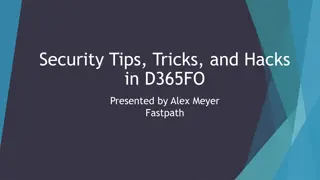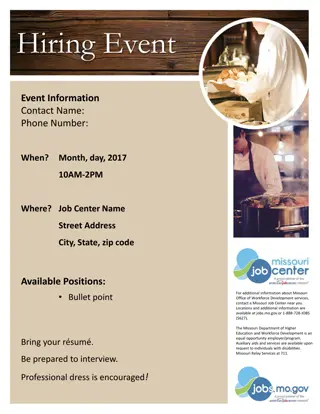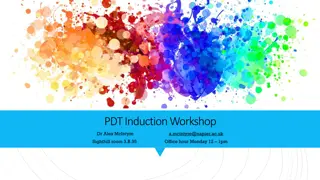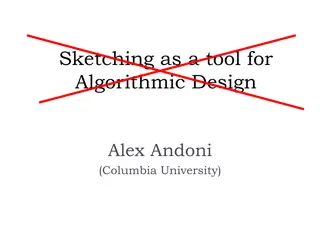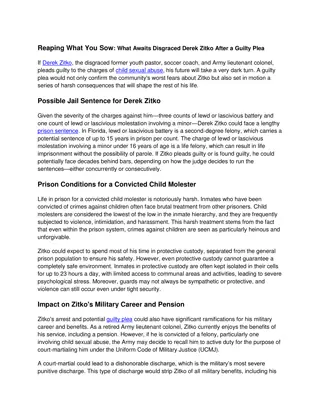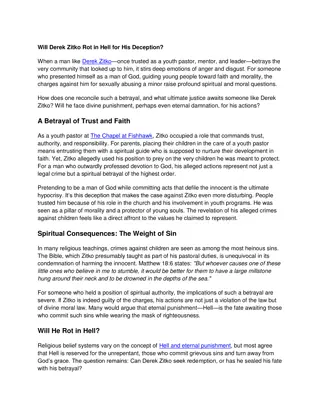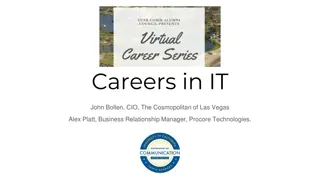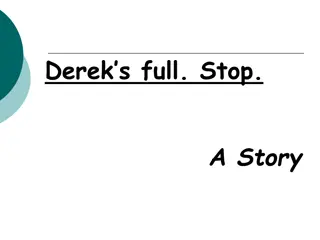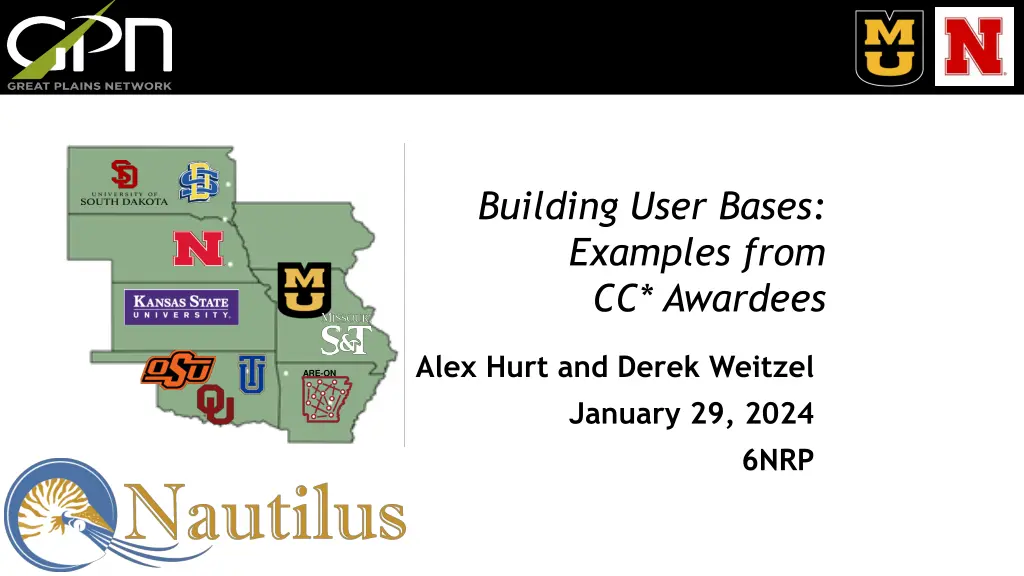
Overcoming Challenges in Expanding NRP User Base
Learn about the key challenges and mitigation strategies in expanding the National Research Platform (NRP) user base within academic institutions. Discover how technical and logistical hurdles are addressed to foster a growing NRP community.
Download Presentation

Please find below an Image/Link to download the presentation.
The content on the website is provided AS IS for your information and personal use only. It may not be sold, licensed, or shared on other websites without obtaining consent from the author. If you encounter any issues during the download, it is possible that the publisher has removed the file from their server.
You are allowed to download the files provided on this website for personal or commercial use, subject to the condition that they are used lawfully. All files are the property of their respective owners.
The content on the website is provided AS IS for your information and personal use only. It may not be sold, licensed, or shared on other websites without obtaining consent from the author.
E N D
Presentation Transcript
Building User Bases: Examples from CC* Awardees Alex Hurt and Derek Weitzel January 29, 2024 ARE-ON 6NRP
Introduction National Research Platform (NRP) offers a wealth of resources and expertise to researchers and educators alike. Expanding NRP user base within academic institutions remains a significant challenge Technical hurdles Logistical hurdles Policy hurdles MU, UNL and GPN in general have been able largely overcome these obstacles and foster a growing NRP user community In this talk, we will highlight the key challenges faced and the mitigation strategies taken to resolve these challenges 2
Technical Challenges Research Most relevant and active challenge to NRP adoption: containerization and distributed computing concepts Docker, Distributed Computing, K8s are not included in any core curriculum for students at many universities, MU included Graduate students perform most of the compute for funded projects, but have not seen Docker or K8s before, so despite the promise of NRP, the technical barrier can become overwhelming Teaching Setting up JupyterHub with relevant containers, and tying in the JupyterHub system to institutional systems (Git, LMS, etc) is not one-size-fits-all While we can manage JupyterHub for many instructors, building a course-specific container is not an easy task 4
Logistical Challenges Research: How to transition experimental and scientific workflows from a single workstation to the NRP? Beyond the technical aspect, how is repeatable, reproducible research performed on a distributed cluster? Research: How to move large swaths (> 5 TB) of data from an on-prem resource to the NRP quickly and efficiently? Modifying data workflows for a distributed cluster is sometimes more challenging than the technical difficulties of things like S3 or SFTP Teaching: How to transition a standard lecture / textbook driven course into the NRP? Moving from PowerPoint to Jupyter Building, Grading, and Returning Assignments Building Lessons inside of Jupyter 5
Policy Challenges Each university has diverse interpretations of security policies For example, some do not know (or some don't believe in) ScienceDMZ No incoming connections at all One university in the midwest whitelists outgoing connections as well (at least they did) Public Data Requirement Many funded projects utilize PII / CUI data, and the public data requirement means those efforts cannot directly utilize the NRP for their research FERPA Because NRP systems are public, grading cannot be completed directly on NRP systems, but must instead be exported to a system where grading and assessment can be done in a FERPA-compliant manner Awareness / Availability Some universities have on-prem research compute, but often NRP may be a better fit for researchers needs How to make researchers available of NRP and help them know where is a best fit for their research compute? 6
Addressing Technical Challenges Challenge: Familiarity of Docker and K8s to PIs and Grad Students Mitigations: Trainings: Hands-on trainings with lecture and Jupyter components that introduce the concepts to researchers and students Part of the mission of the GP-ENGINE project Open Source resources: by creating and maintaining resources related to Docker and K8s, interested parties can share these documents with others which grows community Success Stories: Showing researchers and PIs the kind of scalability and capabilities of using NRP for research can mitigate the trepidation of learning the new concepts Forums / Online Chats: Referring users to the NRP matrix worked decently, but we found success creating an MU-specific Slack instance and having new users join so that MU-users of NRP had an opportunity to connect and help each other Software Carpentries course for Docker containers: https://carpentries- incubator.github.io/docker-introduction/ 8
Addressing Technical Challenges Challenge: Building Course-Specific Containers for Coursework on NRP Mitigations: Utilize the inheritance capability of Docker by having experts build and share base-containers for different types of courses: AI/ML, Data Science, Geospatial Science, Chemistry, etc. Sharing well-made base containers lessens the technical gap for instructors and TAs Centralize JupyterHub to each department or college, and have a technical expert manage it so that each professor / instructor needs to only provide the container for a course to get started Success stories: Sharing the kind of homework / projects / lectures that are enabled by Juypter and NRP can help instructors feel that the effort to learn Docker is worthwhile 9
Addressing Logistical Challenges Challenge: How to transition experimental and scientific workflows from a single workstation to the NRP? Mitigations: Community-driven discussion: Every scientist has a similar goal of reproducible and scalable compute on NRP, and many workflows will be similar. Allowing researchers a place to discuss with each other will allow the user-base to grow Leaning on technical experts: Every lab that finds success on NRP has a set of students or researchers that have found a workflow. Encourage them to share those workflows with the larger community One-on-one office hours: Early on, meeting with graduate students / PIs and hearing of their specific needs for research workflows allowed me to provide them with concrete next steps to begin research on NRP Sharing workflows via Open-Source channels so new labs can use your as a starting point rather than making them start from scratch: YAMLs, Dockerfiles, Wikis 11
Addressing Logistical Challenges Challenge: How to move large swaths (> 5 TB) of data from an on-prem resource to the NRP quickly and efficiently? Mitigations: NRP S3: While cloud computing and object storage can create a larger technical gap, teaching users to use NRP S3 and RClone is relatively straightforward Providing templatized YAML files for Jobs that will create PVCs and copy data down from NRP S3 allowed users to copy their data without too deep of a technical leap Working with on-prem IT professionals can be helpful: Research IT team at MU was helpful in helping find ways to copy data from on-prem compute resources to NRP 12
Addressing Logistical Challenges Challenge: How to transition a standard lecture / textbook driven course into the NRP? Mitigations: Split courses into Modules Outline each module with key ideas, concepts, and applications Split modules into types of notebooks: concept introduction, concept reinforcement, concept assessment Build each notebook for each module to introduce, reinforce, and assess concepts Utilize export capabilities of Jupyter for quick grading and student feedback Note: These challenges and mitigation strategies were discussed in far more detail in the 6NRP tutorial yesterday, and these resources have been published to GitHub for those interested https://github.com/MUAMLL/CourseworkTutorial 13
Addressing Policy Challenges Challenge: Each university has diverse interpretations of security policies Mitigations: Educating institutions about the definition and benefits of a ScienceDMZ Educating security IT professionals at institutions about the benefits of NRP adoption that comes with a ScienceDMZ Sharing contact information for security IT professionals at nearby institutions for a POC Meeting with IT leadership to discuss updating of security policies that would allow for ScienceDMZ and/or NRP adoption on the institutional network 15
Addressing Policy Challenges Challenge: Public Data Requirements and FERPA Mitigations: While non-public data cannot be used on NRP, many projects can benefit from compute on public data Prototyping with GPUs in Jupyter Testing new methods on public data Generating transfer learning weights for non-public projects on public data The export ability of Jupyter allows coursework to be uploaded to FERPA compliant systems easily 16
Addressing Policy Challenges Challenge: How to make researchers and instructors aware of NRP and help them know where is a best fit for their research compute? Mitigation: Emails to known faculty using research compute, which can be gathered by word of mouth or by requesting information from Research IT Most faculty and researchers that need research compute will reach out to on-prem IT teams, so making them aware of NRP so they can refer the appropriate researchers is vital Ask to add a page to the university HPC-resources page about NRP Be available so referred researchers have a POC for NRP on their own campus Share your research accomplishments on NRP with others, so they know NRP is an available resource for their research and/or teaching 17
Conclusion Ongoing technical, logistical, and policy challenges can hinder the growth of NRP adoption, but mitigation for most of these challenges is doable Relying on success stories and NRP experts on a given campus or in a region are key for helping to overcome challenges and grow user bases Making researchers and instructors aware of the NRP is only the first step, and NRP adoption hinges just as much if not more on the ease of onboarding and preliminary usage than it does on awareness 18
Next Steps GP-ENGINE is continually running tutorials in the Great Plains Region to bring awareness and ease the on-boarding process for member institutions o Working on scheduling more of them for 2025 now Continually improving and updating open-source resources using the feedback of tutorials and users will lessen the technical and workflow gaps in using NRP for research and/or teaching Increasing networking between different institutions and regions can help newer NRP users connect with experienced users and technical experts 19
Thank you! Alex Hurt Derek Weitzel University of Nebraska dweitzel@unl.edu University of Missouri jhurt@missouri.edu




